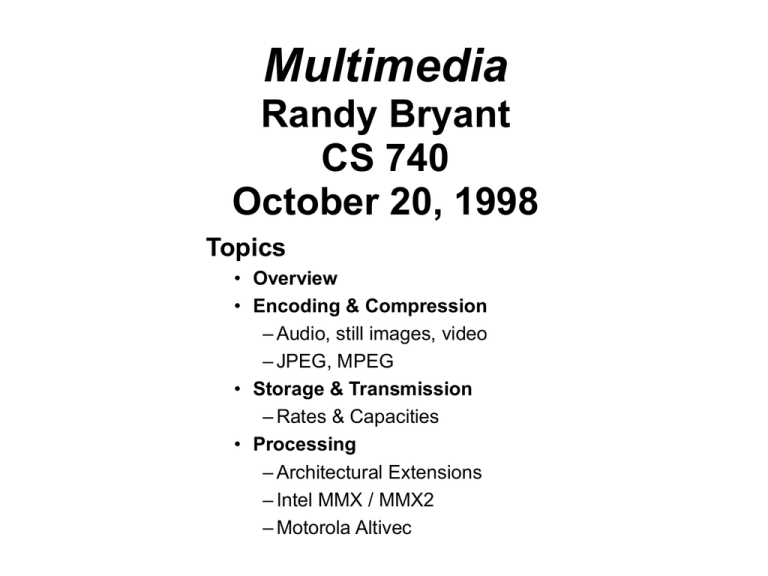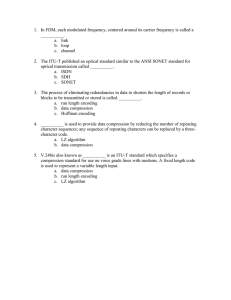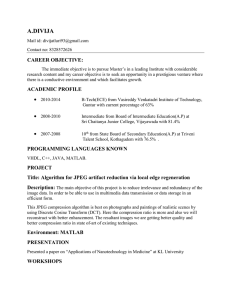Multimedia Randy Bryant CS 740 October 20, 1998
advertisement

Multimedia Randy Bryant CS 740 October 20, 1998 Topics • Overview • Encoding & Compression – Audio, still images, video – JPEG, MPEG • Storage & Transmission – Rates & Capacities • Processing – Architectural Extensions – Intel MMX / MMX2 – Motorola Altivec What is (Digital) Multimedia? • Integration of two or more media using computer technology – E.g., audio, video Reproductions • Still or video images, recorded music or speech Synthesized • Animations, MIDI recordings, virtual reality Major Driver of Computer Technology • High market demand • High computation, communication, and storage requirements – Real time processing required – Requirements scale rapidly with increased quality » E.g., quadratically with image resolution –2– CS 740 S’98 Glossary Storage Sizes • KB = 1024 bytes MB = 1,048,576 bytes GB = 1,073,741,824 bytes Acronym Interpretation • • • • • NTSC JPEG MPEG CD / CDROM DVD –3– U.S. / Japan television standard Still image compression & encoding format Moving image compressing & encoding format Based on compact disk technology Digital Video Disk CS 740 S’98 Complexity Example “NTSC” Quality Computer Display • 640 X 480 pixel image • 3 bytes per pixel (Red, Green, Blue) • 30 Frames per Second Bandwidth • 26.4 MB/second • Corresponds to 180X CDROM • Exceeds bandwidth of almost all disk drives Storage • CDROM would hold 25 seconds worth • 30 minutes would require 46.3 GB Observation • Some form of compression required –4– CS 740 S’98 Lossless Data Compression Original data Compressed data Compressor Decompressor Reconstructed data Principle • Reconstructed = Original • Exploit property that some bit sequences more common than others • Time (compress/decompress) – Space (data size) tradeoff Lempel-Ziv encoding • Build up table of frequenctly occurring sequences • E.g., Unix compress (.Z), DOS Gzip (.zip) • Achieve compression ratio ~ 2:1 (text, code, executables) Huffman Encoding • Assign shorter codes to most frequent symbols –5– CS 740 S’98 Lossy Compression Original data Compressed data Compressor Decompressor Reconstructed data • Reconstructed data approximates original • Want compression ratios ≥ 10:1 Tradeoffs • Time vs. space • Space vs. quality – Greater compression possible if looser approximation allowed Application Dependent • Exploit characteristics of human perception • Examples – Eye’s sensitivity to color variations less than to brightness –6– CS 740 S’98 Digitizing Analog Waveforms Sampler Sampling • Measure signal value at regular time intervals • dt = 1/ Sampling frequency • Nyquist Theorem – Must sample at ≥ 2 * highest frequency signal component – Otherwise get “aliasing” between low and high frequency values Analog/ Digital Analog to Digital Conversion • Convert each sample into k-bit value • Limits dynamic range • Low resolution gives “quantization error” –7– CS 740 S’98 Audio Encoding Frequency Response • Humans can hear sounds ranging from around 5 Hz to 15 KHz • Piano notes range from 15 Hz to 15KHz • Telephone limits frequency range to between 300Hz & 3 KHz Dynamic Range • Humans can perceive sounds over 10 order of magnitude dynamic range • 100 Decibels – Every 3 dB corresponds to doubling sound intensity –8– CS 740 S’98 Compact Disk Recording Parameters • 44,100 samples per second – Sufficient for frequency response of 22KHz • Each sample 16 bits – 48 dB range • Two independent channels – Stereo sound – Dolby surround-sound uses tricks to pack 5 sound channels + subwoofer effects Bit Rate • 44,100 samples/second X 2 channels X 2 bytes = 172 KB / second Capacity • 74 Minutes maximum playing time • 747 MB total –9– CS 740 S’98 CD ROM Technology Basis • Use technology developed for audio CDs • Add extra 288 bytes of error correction for every 2048 bytes of data – Cannot tolerate any errors in digital data, whereas OK for audio Bit Rate • 172 * 2048 / (288 + 2048) = 150 KB / second – For 1X CDROM – N X CDROM gives bit rate of N * 150 – E.g., 12X CDROM gives 1.76 MB / second Capacity • 74 Minutes * 150 KB / second * 60 seconds / minute = 650 MB • Typically around 527 MB to reduce manufacturing cost – 10 – CS 740 S’98 Image Encoding & Compression Computer-Generated Images • • • • Limited number of colors (e.g., ≤ 256) Large monochrome regions Sharp boundaries between regions GIF encoding works well – Lossless compression of 8-bit color images Natural Scenes • • • • • Large number of colors (want 24-bit quality) Widely varying intensities and colors Boundaries not sharp Can eliminate details for which human perception is weak JPEG encoding works well – Lossy compression based on spectral transforms – Can achieve from 10:1 to 20:1 compression with little loss in quality – 11 – CS 740 S’98 JPEG Encoding Steps RGB YUV Encoding Discrete Cosine Transform Quantize Lossless Compression Encoding • Convert to different color representation • Typically get 2:1 compression Discrete Cosine Transform (DCT) • Transform 8 X 8 pixel blocks Quantize • Reduce precision of DCT coefficients • Lossy step Lossless Compression • Express image in information in highly compressed form – 12 – CS 740 S’98 .jpg YUV Encoding Computation • RGB numbers between 0 and 255 • Luminance Y encodes grayscale intensity between 0 and 255 • Chrominance U, V encode color information between –128 and +127 – Similar to Color (Hue) and Tint (Saturation) controls on color TV Conversion Y U V 0.299 = 0.587 0.114 R –0.169 –0.331 0.500 G –0.081 B 0.500 -0.419 • Values saturate at ends of ranges Color Subsampling • Average U,V values over 2 X 2 blocks of pixels • Human eye less sensitive to variations in color than in brightness – 13 – CS 740 S’98 Image Examples • Scanned from CMU catalog • 248 X 324 X 3B • Moiré interference pattern caused by scanning digitized image – 14 – CS 740 S’98 Color Subsampling • 2:1 Compression • No visible effect – 15 – CS 740 S’98 Discrete Cosine Transform Image Partitioning • Divide into 8 X 8 pixel blocks • Express each block as weighted sum of cosines – Similar to Fourier Transform Transform Computation F(u,v) = K(u,v) * Sum(i = 0,7) Sum(j = 0,7) f(i,j) * cos ( [2i+1] * u * /16) * cos ( [2j+1] * v * /16) Inverse Transform f(i,j) = Sum(u = 0,7) Sum(v = 0,7) k(u,v) * F(u,v) * cos ( [2i+1] * u * /16) * cos ( [2j+1] * v * /16) • Expresses image as sum of discretized cosine waveforms – Would be exact, except for roundoff and saturating values • Each waverform weighted by coefficient F(u,v) • Low values of u, v correspond to slowly varying waveforms – 16 – CS 740 S’98 Inverse DCT of Selected Coefficients 0.25 0.2 0.15 0.1 0.05 0 7 -0.05 6 5 -0.1 4 -0.15 3 -0.2 2 -0.25 1 7 6 5 4 0 3 2 1 0 • Coefficient (0, 0) – i.e., F(0, 0) = 1, all others = 0 • Characterizes overall average – 17 – CS 740 S’98 Inverse DCT of Selected Coefficients 0.25 0.25 0.2 0.2 0.15 0.15 0.1 0.1 0.05 0.05 0 7 -0.05 6 0 7 -0.05 6 5 -0.1 4 -0.15 3 -0.2 2 -0.25 1 7 6 5 4 0 3 2 1 5 -0.1 4 -0.15 3 -0.2 2 -0.25 1 7 6 0 5 4 0 3 2 1 0 • Coefficients (1,0) and (0,1) • Capture horizontal or vertical gradient – 18 – CS 740 S’98 Inverse DCT of Selected Coefficients 0.25 0.25 0.2 0.2 0.15 0.15 0.1 0.1 0.05 0.05 0 7 -0.05 6 0 7 -0.05 6 5 -0.1 4 -0.15 3 -0.2 2 -0.25 1 7 6 5 4 0 3 2 1 0 • Coefficient (2,0) • Captures vertical banding – 19 – 5 -0.1 4 -0.15 3 -0.2 2 -0.25 1 7 6 5 4 0 3 2 1 0 • Coefficient (1,1) • Captures diagonal variation CS 740 S’98 Inverse DCT of Selected Coefficients 0.25 0.2 0.15 0.1 0.05 0 7 -0.05 6 5 -0.1 4 -0.15 3 -0.2 2 -0.25 1 7 6 5 4 0 3 2 1 0 • Coefficient (7,7) • Captures high spatial variations – 20 – CS 740 S’98 Quantization Quantization Coefficient Q(u,v) for each waveform (u,v) • Approximate F(u,v) as Q(u,v) * Round[ F(u,v) / Q(u,v) ] – E.g., if Q is 2k, just round low order k bits to 0 • High value of Q gives coarser approximation Selecting Q’s • Increase to get greater compression – Major source of loss in JPEG • Generally use Q’s that increase with u and v – High spatial frequencies not as important – Hope that many coefficients will be set to 0 – 21 – CS 740 S’98 JPEG Compression Examples 28:1 Compression Original Compressed • Quality still reasonable • Some loss of fine detail – 22 – CS 740 S’98 JPEG Compression Examples 66:1 • Quality drops dramatically as increase compression ratio • Throws out color information first – 23 – CS 740 S’98 JPEG Compression Examples 101:1 86:1 – 24 – CS 740 S’98 DCT Quantization Effects Blow Up Sections of Low Quality Images • See 8 X 8 blocks • Only low frequency coefficients for Y • Extreme subsampling for U, V – Single value for 16 X 8 pixels – 25 – CS 740 S’98 MPEG Video Encoding MPEG-1 • Targeted to “VHS” quality video on CDROM – 352 X 240 pixels – Display on computer screens • Two forms of lossy compression – Spatial compression similar to JPEG – Temporal compression exploiting similarity between successive frames » E.g., stationary background, panning MPEG-2 • Broader range of applications – Including Digital Video Disk (DVD) players • Support for fancier features • Aim for baseline of 720 X 480 pixels – 26 – CS 740 S’98 Baseline MPEG-1 Video Channel • 352 X 240 pixels, with subsampling of chrominance to 176 X 120 • 30 frames per second • 26:1 compression drops bit rate to 143 KB / second Audio • Compress CD sound by 6:1 • Bit rate = 32 KB / second Performance • 175 KB / second matches performance of early CD ROM drives • Store > 1 hour on CD • Software-only decoders running on PC-class machines cannot decode fast enough – Typically limited to 8–10 FPS – 27 – CS 740 S’98 DVD Using MPEG-2 Video Channel • 720 X 480 pixels, with subsampling of chrominance to 360 X 240 • 30 frames per second • 70:1 compression drops bit rate to 440 KB / second Audio • Uncompressed audio CD quality • Bit rate = 176 KB / second Capacity • 2 sides, each with 4.38 GB capacity • 612 KB / second • Approx. 4 hours playing time – 28 – CS 740 S’98 MPEG Encoding ••• ••• I1 B1 B2 B3 P1 B4 B5 B6 P2 B7 B8 B9 I2 Frame Types I P B Intra Encode complete image, similar to JPEG Forward Predicted Motion relative to previous I and P’s Backward Predicted Motion relative to previous & future I’s & P’s – 29 – CS 740 S’98 Frame Reconstruction I1 I1+P1 I1+P1+P2 ••• ••• • I frame complete image • P frames provide series of updates to most recent I frame updates P1 – 30 – I2 P2 CS 740 S’98 Frame Reconstruction (cont). I1 I1+P1 I1+P1+P2 ••• I2 ••• Interpolations • B frames interpolate between frames represented by I’s & P’s – 31 – B1 B2 B3 B4 B5 B6 B7 B8 B9 CS 740 S’98 Updates / Interpolations Describe how to construct 16 X 16 block in new frame • Block from earlier frame • Block from future frame (B frame only) • Additive correction Encoding • All blocks coded using format similar to JPEG Example Numbers • • • • • 320 X 240 X 148 frames 10 I frames 18.9 KB average 40 P frames 10.6 KB average 98 B frames 0.8 KB average 148 total 4.7 KB average – 32 – 6:1 compression 11:1 compression 141:1 compression 24:1 compression CS 740 S’98 Bandwidth Requirements Consider MPEG-1 (352 X 240) vs. MPEG-2 (720 X 480) • Video portion only • Uncompressed 3.6 MB / s • Compressed 0.14 MB / s 14.8 MB / s 0.43 MB / s Pentium 800 MB / s cache 133 MB / s bridge/memory controller PCI local bus 20 MB / s video capture DRAM SCSI-2 card graphics card 4 MB / s Disk – 33 – CS 740 S’98 Capture Raw Video to Disk MPEG-1 7.2 MB / s 3.6 MB / s 3.6 MB / s PCI SCSI-2 Disk MPEG-2 29.6 MB / s 14.8 MB / s 14.8 MB / s (OK) (OK) (No Way!) Pentium cache bridge/memory controller PCI local bus DMA from capture video capture DRAM SCSI-2 card graphics card DMA to disk Disk – 34 – CS 740 S’98 Decompress & Playback MPEG-1 7.5 MB / s 0.14 MB / s 0.14 MB / s PCI SCSI-2 Disk MPEG-2 30.5 MB / s 0.43 MB / s 0.43 MB / s Read compressed Pentium Reconstruct Frames cache bridge/memory controller PCI local bus (OK) (OK) (OK) DMA raw to graphics video capture DRAM SCSI-2 card graphics card DMA comp. from disk Disk – 35 – CS 740 S’98 ISA Extensions to Support Multimedia Microprocessor Report 11/18/96 • CPU manufacturers extending architectures to support multimedia • Low precision (1 & 2 byte), saturating arithmetic • Vector operations – 36 – CS 740 S’98 Digital MVI Standard Alpha • Can do most multimedia tasks in software – Sledgehammers make good fly swatters • Cannot do MPEG-2 encoding in real time – Motion estimation is very demanding – Must compare 16 X 16 blocks with blocks from other frames Extensions • Packing & unpacking smaller (1, 2, 4 byte) integers • Special instruction used in motion estimation – Perr Ra, Rb, Rc – Ra, Rb vectors of single byte words – Rc = SUM(i = 0, 7) | Rai – Rbi | – 37 – CS 740 S’98 MIPS MMDX Overload Use of FP Registers • Doesn’t add any new architectural state – Would require OS changes to support context switching • 64-bit data values • View as vector of small integers – 8 single byte words – 4 two-byte words • Operations – Addition, multiplication » Different vector modes » Saturating – Rearrange » Shuffle, pack, unpack – 38 – Microprocessor Report 11/18/96 CS 740 S’98 Intel MMX Similar to MIPS • Overload use of FP registers – Only 8 available – Not nearly enough • View as vector of integers – 1, 2, or 4 bytes each Microprocessor Report 3/5/96 – 39 – CS 740 S’98 Intel MMX2 • Announced by Intel for next generation processor – Code name “Katmai” Adds New Architectural State • 8 registers, each 128-bit – Limited by 3-bit encoding field in instruction • Realized that MMX was inadequate Support Floating Point Operations • Each register holds 4 single precision values • Perform 4 element-wise operations (+, *, sqrt) in parallel Use Original MMX Registers for Integers • Added sum-of-absolute-differences instruction – Similar to Alpha’s Processor / Memory Enhancements • Various forms of prefetch operations – 40 – CS 740 S’98 Motorola Altivec • Added to next generation (G4) PowerPC processor Adds Lots of Architectural State • 32 new registers, each 128 bits • Need lots of registers to allow efficient loop unrolling • 4 data formats – Integers: 16 X 8 bits, 8 X 16 bits, 4 X 32 bits – Floating Point: 4 X 32 bits Wide Variety of Operations • Arithmetic • Packing / unpacking • Permutations High Overhead • 17 mm2 out of < 100 mm2 die area – 41 – CS 740 S’98




